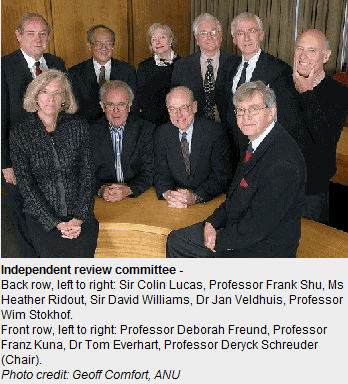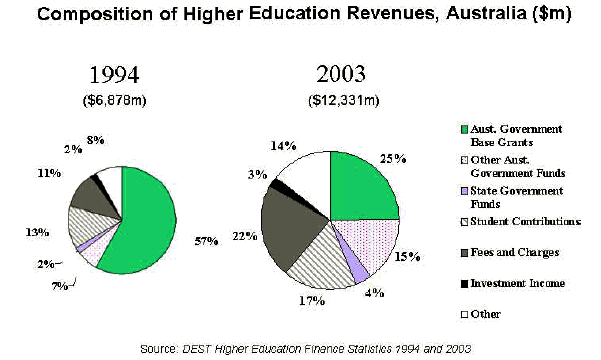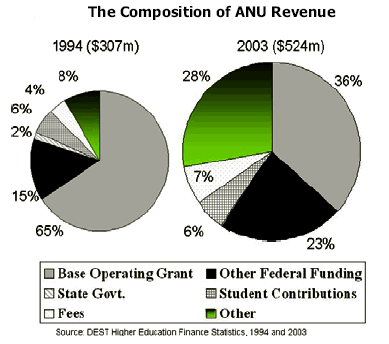|
Opinion- 28 September 2004 |
|
Quality
[see also Peter Hall's Report on the release of the review] |
 The Minister at the time of the establishment
of the Australian National University (1946), J.J. Dedman, defined the
mission of the new University as intended,
The Minister at the time of the establishment
of the Australian National University (1946), J.J. Dedman, defined the
mission of the new University as intended,
to advance the cause of learning and research in general, and take its rightful place among the great universities of the world.
With the establishment of an Australian national university ...Australia will have taken one more step to align itself with the great and enlightened nations of the world.
Now fifty-eight years later, the Chair of the ANU review, Professor Deryck Schreuder, has introduced the committee's report saying "our focus is on the outcomes measured against international comparators of like research-led universities. We here emphasise analysis centred on peer review applied to knowledge outcomes; and on peer perspectives, concerning the overall shape, character and future of the university" [our emphasis].
At the outset it is appropriate to note that with the completion of its review the committee came to the conclusion that, "On the basis of all the available evidence and our own observations, we confirm the standing of ANU within the elite “Top 100” research intensive universities of the world, even among the top 50 or so." And suggest that while the research university rankings by "Shanghai Jiao Tong University's Institute of Higher Education may be suggestive indicators, invariably such rankings bring many criticisms over the limitations to their methodologies and the comparability of institutions from different national systems." But the review also notes that ANU was ranked 53 this year (in 2003 its ranking was 49).
So perhaps the Chinese university's methodology may have some validity. If that is the case, and if the focus of the review is to compare ANU against international competitors of like research-led universities, perhaps the fact the the Shanghai Jiao Tong University (SJTU) rankings lists six of the University of California's campuses in the top fifty (4, 13, 16, 17, 35, 42) would be considered both of relevance and consequence.
And while taking note of the review committee's caveat that SJTU's rankings will have their limitations, nevertheless the actual scores achieved by the institutions have there interest. With Harvard as number 1 set equal to 100. Stanford, (2) scored some distance behind at 77.2. The six UC campuses gained scores of 74.2, 53.8, 51.6, 50.8, 37.0 and 33.6. ANU (53) is given a score of 31.9 which would place it below UC-Davis (33.6) but just above UC-Irvine (ranked 55, scored 31.4). The University of Melbourne, the only other Australian university in the top 100 and ranked 82 by SJTU scored 26.8.
 The
point is not to belittle the achievements of ANU, clearly the review committee
which consists of the most eminent group of academics to have ever reviewed an
Australian tertiary institution*
has given the national university high praise, but if Australian academe is to
attract and keep outstanding academicians and researchers it will have to compete at the highest
levels, i.e. against the very best institutions and research environments (read most attractive
from the viewpoints of infrastructure, funding and collegiate environment).
The
point is not to belittle the achievements of ANU, clearly the review committee
which consists of the most eminent group of academics to have ever reviewed an
Australian tertiary institution*
has given the national university high praise, but if Australian academe is to
attract and keep outstanding academicians and researchers it will have to compete at the highest
levels, i.e. against the very best institutions and research environments (read most attractive
from the viewpoints of infrastructure, funding and collegiate environment).
From 1998-2002 ANU had a citation proportion some 23% higher than the Group of Eight as a whole. That of itself it is a strong indication of the research intensity at ANU and if the federal government were serious about building toward an academic research critical mass it would appear reasonable to determine a place to start "getting serious" rather than continuing to spread an inadequate quantity of 'Dynamic Lifter' in a monomolecular film.
The review committee singled out an assessment by Jeremy Knowles, the Amory Houghton Professor of Chemistry and Biochemistry at Harvard who served as Harvard's dean of the Faculty of Arts and Sciences from 1991 until June 2002 before returning to his faculty position. Knowles served as chair of an external moderation panel that advised the review committee.
"[Professor Knowles] came to a most positive impression of ANU research:"
Overall, and assessing the ANU as the premier institution of higher education in Australia, there is no doubt that – even though it is sui generis (in having been founded as a collective of research schools that has developed and grown into a University that contributes directly to the education of undergraduates) – by all accepted international standards, the ANU is a distinguished, attractive, and impressive institution of which Australia must be proud. The assessment exercise that you have generated has been undertaken with care and independence, and essentially all the metrics confirmed for us that the ANU is very highly regarded, even when measured against the best institutions of higher learning, world-wide. We examined the assessment methodology with some care, and found that the home institutions of the assessors (both in Australia and abroad) are mostly of the first rank, that an appropriately high proportion of the assessors (85%) were from outside Australia, and that the final weighted averages of research and scholarship by discipline deemed to fall into the top two “world-class” categories (of “Exceptionally Significant” and “Internationally Excellent”) is impressively high. In terms, therefore, of an overall view of your University, we found an enviably high standard.
"We come to a similar finding."
While the review concentrated on ANU, it provided two pie charts which are graphic proof of federal governments' substantial abrogation of its responsibility for support of Australia's tertiary institutions over the past decade. Base funding dropped from 57% to 25% for the higher education sector as a whole, and from 65% to 36% for ANU.


Finally, the review committee submitted fifteen recommendations one of which directs the federal government to sustain and progressively increase block grant funding for ANU research because of the University’s key national role. Below is ANU's summarised version of the recommendations followed by appropriate links for those interested in the detail.
In addition the committee listed three "matters for further consideration".
There are significant areas of research strength at ANU that are not reflected in the undergraduate curriculum.
We suggest the University consider undertaking a specific survey of international student perspectives.
Aging staff profiles, gender imbalance, the need to provide career opportunities for new staff, multi-skilling and leadership development are all pertinent issues that need to be addressed.
SUMMARISED RECOMMENDATIONS OF THE 2004 QUALITY REVIEW OF ANU
For the full detail of each recommendation, please refer to the full text of the
Committee’s report.
The ANU Council should reaffirm the University’s special national mission.
The ANU Council should commit to a far-reaching vision that includes extending and deepening international links; expanding the use of the University’s research training capacity; developing distinctive research-led undergraduate education and helping build the resources required to sustain the university in future.
ANU should strengthen national and international ties through alliances with business, research and government communities in the ACT, Australia and the rest of the world.
ANU should aspire to offer an elite, residential undergraduate experience, led by research and including work experience.
The Australian Government should remove its restrictions on the University’s intake of Australian higher degree research students.
ANU should develop more postgraduate scholarships to expand research training.
ANU should expand its revenue base through public policy development and professional and graduate training.
ANU should develop closer relationships with other research-intensive universities in order to benchmark research and education, and offer more overseas study.
ANU should collaborate with government to expand its policy development role in keeping with its national capital location and national mission.
ANU should strengthen its links with other national institutions, such as the National Library of Australia and CSIRO.
ANU should become a pre-eminent ‘Asia university’ both through collaboration with the region and as a gateway for the rest of the world into the region.
ANU researchers should ‘aim higher’ when publishing their results and approach the most prestigious journals.
ANU should expand its revenues through greater levels of national public policy service and expanding professional and graduate education to meet national and international needs.
The Australian Government should sustain and progressively increase block grant funding for ANU research because of the University’s key national role.
- ANU should improve internal cooperation and integration to enable more cross-disciplinary collaboration.
The Review will be used to develop a strategic plan for the strengthening of ANU over the next five years.
The full report of the Review Committee is available at: www.anu.edu.au/review
ANU Material provided for the Review :
* The review committee, chaired by Professor Deryck Schreuder (former VC of the University of Western Australia), comprised Tom Everhart (former President, Caltech), Deborah Freund (VC and Provost, Syracuse University), Franz Kuna (former PVC, Klagenfurt University, Austria), Colin Lucas (VC, Oxford University), Heather Ridout (Chief Executive, Australian Industry Group), Frank Shu (President, National Tsing Hua Univeristy, Taiwan), Wim Stokhof (Director, International Institute of Asian Studies, Leiden, The Netherlands), Jan Veldhuis (former President, Utrecht University, The Netherlands) and David Williams (former VC, Cambridge University).
Alex Reisner
The Funneled Web